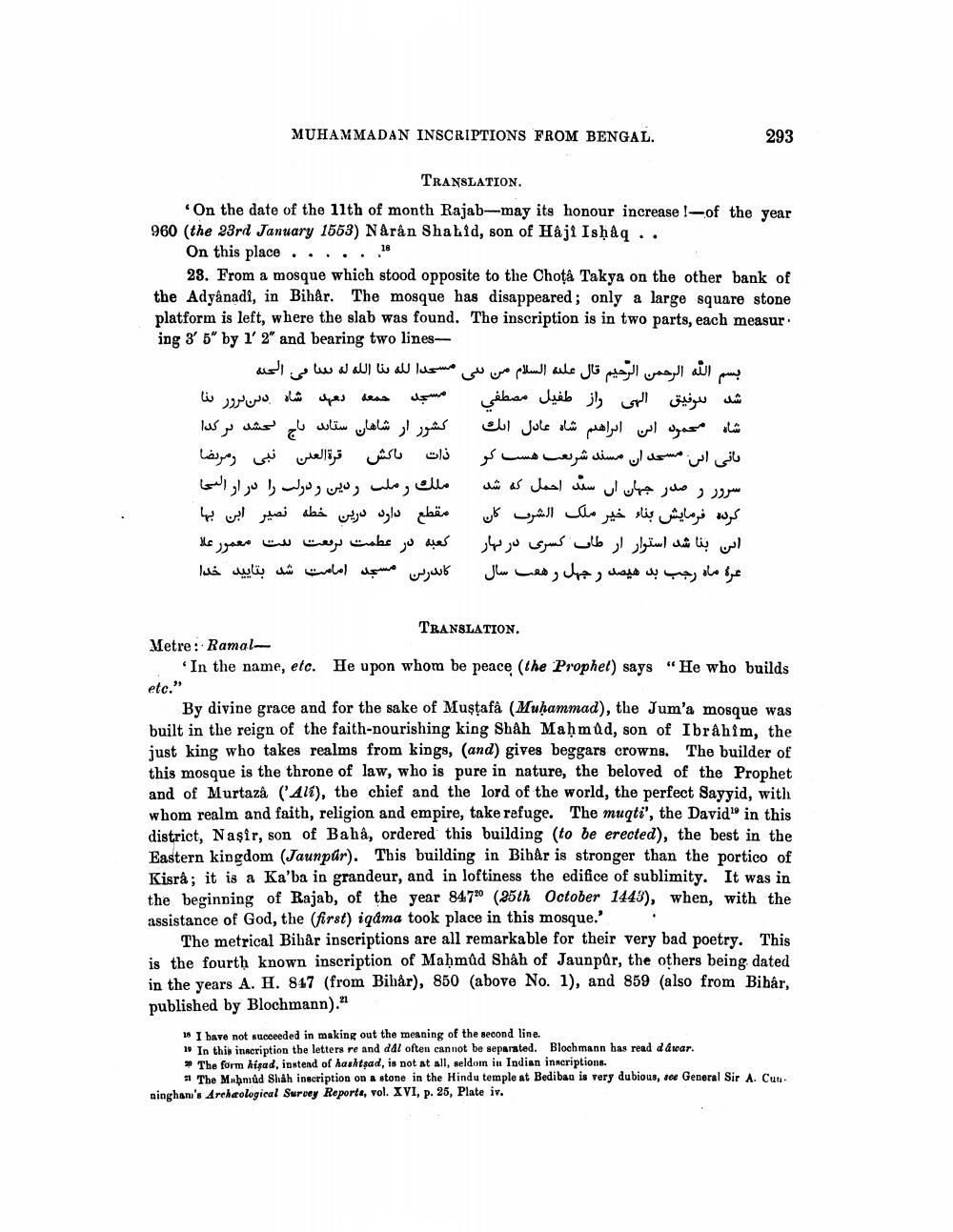________________
MUHAMMADAN INSCRIPTIONS FROM BENGAL.
293
TRANSLATION. On the date of the 11th of month Rajab-may its honour increase ! -of the year 960 (the 23rd January 1563) Nárån Shahid, son of Haji Ishaq ..
On this place ......18
28. From a mosque which stood opposite to the Choţà Takya on the other bank of the Adyanadi, in Bihår. The mosque has disappeared; only a large square stone platform is left, where the slab was found. The inscription is in two parts, each measur ing 3' 5" by l' 2" and bearing two lines
بسم الله الرحمن الرحيم قال عليه السلام من سی مسجدا لله بنا الله له بيا في الحيه
دین برور بنا
شاه جمعه دهد
مسجد طفیل مصطفی
راز
الهی شد سوفیق
كشور ار شاهان ستاند باج تحشد در کدا
الك ابراهیم شاه عادل شاه محمود این
ومريضا
نبي قرة العين پاکش
ذات بانی انى مسعد ان مسند شریعت هست کر
ملك رملت ردین و دولت را در ارالی سرور رصدر جهان ای سند احمل که شد
مقطع دارد درین خطه نصير ابن بها كان
الشريف بناء خیر ملک کرده فرمایش
کعبه در عطمت برفعت ست معمور علا
کسری در بهار این بنا شد استوار ار طای
کاندرین مسجد امامت شد بتایید خدا عره ماه رجب بد هيصد ر جهل و هفت سال
TRANSLATION. Metre : Ramal
In the name, etc. He upon whom be peace (the Prophet) says "He who builds etc."
By divine grace and for the sake of Mustafà (Muhammad), the Jum'a mosque was built in the reign of the faith-nourishing king Shâh Maḥmad, son of Ibrahim, the just king who takes realms from kings, (and) gives beggars crowns. The builder of this mosque is the throne of law, who is pure in nature, the beloved of the Prophet and of Murtaza (Ali), the chief and the lord of the world, the perfect Sayyid, with whom realm and faith, religion and empire, take refuge. The muqti', the David" in this district, Naşir, son of Baha, ordered this building (to be erected), the best in the Eastern kingdom (Jaunpdr). This building in Bihar is stronger than the portico of Kisrá; it is a Ka'ba in grandeur, and in loftiness the edifice of sublimity. It was in the beginning of Rajab, of the year 84720 (25th October 1443), when, with the assistance of God, the (first) iqdma took place in this mosque.' .
The metrical Bibâr inscriptions are all remarkable for their very bad poetry. This is the fourth known inscription of Mahmud Shah of Jaunpur, the others being dated in the years A. H. 847 (from Bihår), 850 (above No. 1), and 859 (also from Bibár, published by Blochmann).
18 I have not succeeded in making out the meaning of the second line. 19 In this inscription the letters re and ddl often cannot be separated. Blochmann has read d d war. >> The form hisad, in tend of hashtpad, is not at all, seldom in Indian inscriptions
11 The Mahmud Shah inscription on a stone in the Hindu temple at Bedibao is very dubious, see General Sir A. Cun. ninghani's Archeological Survey Reporte, vol. XVI, p. 25, Plate iv.




